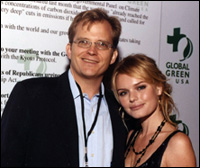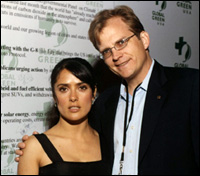
Matt Petersen.
What’s your job title?
President and CEO of Global Green USA, the U.S. affiliate of Green Cross International.
What does your organization do? What, in a perfect world, would constitute “mission accomplished”?
When founding Green Cross International, Mikhail Gorbachev presented a challenge: We must foster a value shift that reconnects humankind to the environment. Planet Earth would do just fine without humans, but we must ensure the health of the planet in order to ensure humanity’s continued survival.
Global Green USA and Green Cross International focus on three of the greatest challenges facing humanity: eliminating weapons of mass destruction, ensuring access to clean water for all of humanity, and combating global warming.
Mission accomplished would be a successful response — by the entire environmental community, and all of humanity for that matter — to Gorbachev’s challenge.
What are you working on at the moment?
All our work includes a focus on communities, whether it is helping get a health clinic for a destitute community that rests in the shadow of a nerve gas warehouse in Russia or supporting efforts to build cisterns in a village in the arid region of Bolivia. Firsthand knowledge and on-the-ground experience are used to strengthen our broader education and advocacy initiatives, like our push in the U.S. Congress to get continued funding to destroy Russian chemical weapons or our global water treaty campaign.
A central aspect of our organizational strategy in the U.S. is revitalizing communities from the inside out, by focusing on greening schools and affordable housing.
In greater Los Angeles alone, Global Green USA has led campaigns to green $15 billion in construction of schools, colleges, and affordable housing. We work with developers and school districts directly, helping ensure projects are built green. The direct lessons we learn on the ground are then taken to city hall, our state capitol, or Washington, D.C., to make better policy.

Matt Petersen works with Hollywood celebs like Kate Bosworth …
Photo: Global Green USA.
This work creates the clean jobs of tomorrow today, rather than continuing with the dirty jobs of yesterday. Given that buildings use 40 percent of the world’s resources and energy, green schools and housing are also real solutions to global warming. On the global scale, our call for a Global Solar Fund of $50 billion would focus on putting solar in urban communities to reduce peak demand and provide clean electrification for the 2 billion “energy impoverished” in the developing world.
At the same time, we are working with the entertainment industry to educate and motivate the public about the challenges and the solutions. We do an annual campaign to get celebrities into hybrid cars, such as the Prius, to go to the Oscars. This sends a message to people across the U.S. that hybrids are fun to drive — even sexy, as Will Ferrell put it — as well as being smart solutions to global warming and reducing our dependence on oil.

… and Salma Hayek.
Photo: Global Green USA.
We also took elected officials, business leaders, and celebs Salma Hayek and Jake Gyllenhaal to the Arctic Circle to learn firsthand the impact of global warming on the Inuit people, who are the canary in the global coal mine, experiencing impacts at a rate two to three times that of the rest of the world.
We’ve encouraged the public to join with people like Leonardo DiCaprio and Charlize Theron in signing our Pledge of Allegiance to American Energy Independence.
What long and winding road led you to your current position?
I came in touch with the founder of Global Green USA, Diane Meyer Simon, in early 1994. I had previously run political campaigns, and was then in grad school at the University of Southern California getting my master’s in public administration and working full-time running a small environmental group. Diane, a former political staffer, and I hit it off, and we talked about me coming to work with her. The timing wasn’t right, but six months later I got a call from Diane asking me to come set up Gorbachev’s trip to launch Global Green in California and establish the organization. It’s been an incredible journey ever since, and I owe a debt of gratitude to Diane for believing in me.
How many emails are currently in your inbox?
I have about 1,000 that I just winnowed down from 1,200 this past week by deleting and filing. It is a big challenge to keep deleting emails that don’t need to be saved and responding to all the emails I get daily. I’m often up late at night sending emails to colleagues in Europe, getting into exchanges with them at the beginning of their day (midnight in L.A. is 9 a.m. in Geneva or Paris).
Where were you born? Where do you live now?
I was born in Sonora, Calif., raised in Modesto, Calif., and have lived in Santa Monica, Calif., for 12 years now.
What environmental offense has infuriated you the most?
I serve on the Santa Monica environmental task force as part of my commitment to my community and a way to experience policy making at the community level firsthand. We’re doing a lot of great things here through the City of Santa Monica’s sustainable city program. One of my pet peeves on the task force has been declining recycling rates. I was once walking in our alley and saw a neighbor — someone I did not know, a common occurrence living in an apartment/condo-heavy neighborhood — drop an unread Sunday Los Angeles Times in the trash can when a recycling can was right next to him. When I told him, he apologized and said he couldn’t reach the paper now. I feel like we should task Boy Scouts to patrol trash cans for newspapers, cans, and bottles, and perhaps “write a ticket” for those that have recyclables in their trash. As a kid I remember the Boy Scouts were the organizers of newspaper recycling, so perhaps they’d accept this new task!
Who is your environmental hero?
People like Ray Anderson and Paul Hawken are great inspirations; E.O. Wilson too.
For the pragmatic environmentalist, what should be the focus — political action designed to change policy, or individual action designed to change lifestyle?
We need both. In the U.S., we are in need of an awakening. The environmental movement needs to reach out to organizations and community leaders to find ways to make the issue and challenge of climate change relevant to people (and improve media coverage of the issue). If we don’t, we will fail to build the political will necessary for action. Part of making climate change relevant is to make sure PTA presidents, affordable-housing developers, and other community advocates all see how it can impact their lives, but also how solutions can benefit them and their work. Let’s make climate solutions work for everyone, not just utilities and large polluters.
I’m not criticizing my colleagues here, as others have done. Working inside the Beltway is critical, but as the recent World Environment Day activities in San Francisco reinforced, we also have to work at the community level. We have to educate and empower vast sectors of our society, an increasing challenge given the media clutter.
Remember, soccer moms don’t just vote, they go to school-board and PTA meetings. Chiding them for driving SUVs is one thing, but we have to help them understand how climate change will change their lives and how a solution like green schools improves their child’s test scores at the same time.
What’s your environmental vice?
For work, it’s plane travel, of course. Personally, it’s takeout food. Thankfully, my wife and I have cut back a lot on dinner takeout since we’ve had our son.
What are you reading these days?
I thumbed through the laughable State of Fear by Crichton, and am reading Tale of Two Cities, which somehow I got away with never reading in school. Also on my desk: Gary Erickson’s Raising the Bar and David Orr’s latest book, The Last Refuge.
If you could institute by fiat one environmental reform, what would it be?
Tough to choose … on a specific issue, it would be creating binding federal greenhouse-gas emission reduction targets in the U.S. that get us toward the 70 percent in reductions scientists estimate we need to avoid climate catastrophe.
Let me choose something more systemic, however. Too often, government and corporate policies and actions detrimental to our environment and human health are upheld in the name of increasing shareholder value. We need to return the public good to the equation.
Despite the lack of leadership on climate change at the federal level and the rolling back of existing environmental laws in Washington, D.C., there is movement on this front.
A few companies have embraced the notion that shareholder value and protecting the public good (including the environment) are not mutually exclusive; rather, they are one and the same. Many cities, and some states, are putting in place progressive policies.
Most exciting right now on this front is the movement by pension funds — led in particular by the California Public Employment Retirement System (CalPERS) — to invest in green technologies, urban communities, and green building, and require disclosure of climate risk.
Creating more demand for green technologies via green building policies at the local level and spurring investment via green funds — including those by CalPERS and other pension funds — will drive innovation and lower costs. Targeted initiatives can also create greater societal benefit.
For example, our work with affordable housing developers to create net-zero-energy homes, and concurrent legislation in California to create a revolving loan fund for solar on low-income housing, not only help drive down the cost of solar, reduce GHGs, and create clean jobs, but lower energy bills for low-income families, helping them rise out of poverty.
We can envision a different future. We need a market that integrates externalities, reflecting the true costs of goods and services, and encourages innovation, rather than dumping pollution on the developing world, our communities’ poor, and future generations.
What was your favorite band when you were 18? How about now?
INXS, maybe Simple Minds when I was 18. Now, the Beastie Boys are loving the top spot and since my son became a classical music aficionado, Mozart has become oft-listened-to as well.
What’s your favorite movie?
I just watched The Last Wave, directed by Peter Weir. It was pretty amazing.
What are you happy about right now?
My wife and son.
If you could have every InterActivist reader do one thing, what would it be?
Sign our Pledge of Allegiance to American Energy Independence, and make a donation to Global Green if you can. Ask your city council and school board to adopt a green building policy for future construction projects. And sign our international water treaty petition.

